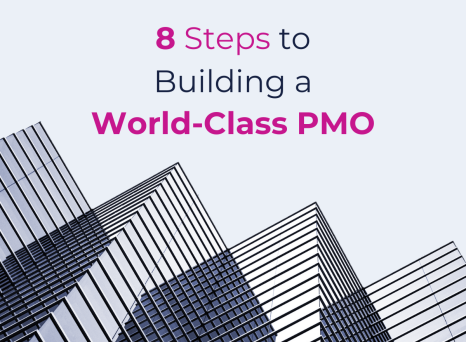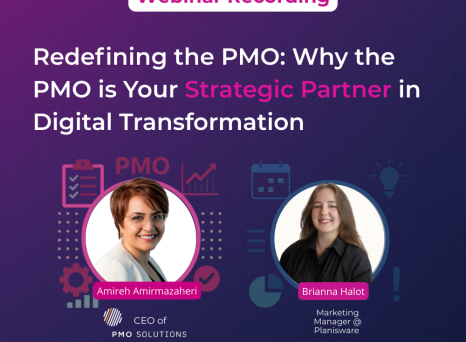Quick! Who would be your go-to partner for realizing your organization's strategy? If you didn't think of the PMO, you're losing out on a powerful tool to strengthen your company's competitive advantage.
The PMO occupies a unique position within a company, as it focuses all the data about the organization's key initiatives: projects, products, portfolios, technologies, resources etc.
But the PMO is not just a passive data gathering group. It also has the tools and the power to help make optimal strategic choices and respond to uncertain environments.
Something that is completely instrumental in having a great PMO organization is recognizing the power that it can have.
-- Aimee Rodrigues from the PMO Strategies Podcast Episode 114
How is the PMO a Strategic Tool?
The Project Management Office (PMO) is the entity that maintains all standards for best practices in project management across the organization. Instead of individual teams creating their own timelines and tracking project status, the PMO creates “one body and one organization.”
Let's firstly talk about the position of the PMO. We often rank people within a company based on the responsibilities or the decision-making capabilities that they hold. In this regard, the PMO is nicely snuggled in between ground level project execution who deal with day-to-day operations and the C-level executives who are making the cutting-edge decisions. The problem with these cutting-edge decisions is that leadership often falls victim to the problem “of putting the cart before the horse”. This is where the strategic tool (i.e. The PMO) can come into play. The PMO will not only gather the data in the correct format for different stakeholders, but it will also anticipate certain risks (What? A Global pandemic? Nah... Will never happen...) allowing executives to quickly assess the impact on projects and portfolios.
With PMO guidance, the right tools and people are assigned to the right places. The PMO makes sure that data is being shared and acts as the point of contact between leadership and project teams.
[The PMO's role] is to help the organization deliver on its strategy with the highest possible return as quickly as possible.
-- Laura Barnard
This is because the PMO guarantees that teams are “working on the right things with the right people, using the right resources, and allocating the right budget,” as Aimee Rodriguez referred to in her most recent podcast. Before projects are started, the PMO runs simulations to create workflow timelines that include the expected time to complete a project. They take variables and run these simulations to find the best case to finish a project while also considering return on investment.
At the same time, PMOs run “what-if” scenarios. These are potential events that can delay a project and the PMO creates alternative paths to pivot if they happen. With scenarios already revealed, PMOs can pivot projects without a delay or affecting other projects running at the same time.
Once the strategy is set by company leaders, translated into actionable projects by the PMO, and assigned to project teams, the marathon towards deliverables starts.
Why is having a “Strategic” PMO so important today?
A familiar experience between project managers and company leadership, is a last-minute suggestion that leadership wants to include that could derail progress. While leadership thinks this change won't have ripple effects, the PMO evaluate the idea by running new scenarios to see if/how it can fit current projects.
This was not always the case, and when we reflect on eras such as Jack Welch's in GE, we realize that business models used to stay unchanged for years and remain highly successful. Resilience and company success now depends on a company's ability to adapt to change and guess what? Your hidden gem to ensuring that resilience is giving the PMO a seat at the table. One major change will only trigger many others down the road, so battening down the hatches to let one transformation blow over will only result in further problems. Fortunately, the PMO excels in these situations, where Covid forces us all to work from home, resulting in digital transformation (on steroids), resulting in relocation to more rural areas etc. etc. You get the point.
Overall, if there is a negative project impact, the PMO can respond to leadership quickly with data and a first-hand view of the organization's current capacity. Another indirect benefit of having the PMO respond to leadership is that teams stay focused on project work while the PMO communicates around strategy, valorizing their work and keeping everyone on the team motivated.
A new strategic idea growing within companies is called optionality. This refers to keeping as many options open as possible to avoid dependencies or limiting choices. Instead of creating one unbreakable roadmap, the PMO can preemptively create fallback plans that can be implemented quickly and rolled out company wide.
This was seen in pharmaceutical companies with the global pandemic. They set strategies for the entire year and then instantly they had to pivot when COVID cases rose exponentially. Not only were standard operating procedures affected like who could work in-person and who would work remotely, restructuring project plans and timelines, and creating new protocols; but when vaccine and therapeutic teams were assigned towards new drug development, preexisting projects still had goals to meet. The PMO can pivot and realign because it uses past project data experience when it builds scenarios and the what-if possibilities. It's also the PMO's deep knowledge of company methodologies that can make sure that projects can be changed and assigned priority without affecting other teams.
What competencies should a PMO have to be more strategic?
The PMO understands strategic thinking and can translate the company's strategic goals effectively. Strategic thinking, by the PMO, is helping company success in three distinct ways:
- Communication across the entire organization
- Intelligent project planning through scenario analysis
- Data-supported decision making
There is no vagueness with the PMO, it lives in a data-driven world. And that world starts inside a single solution rather than multiple systems sharing data.
A single source of data truth is the first step. Instead of multiple systems that import and share data, a single solution offers unified and trusted data, and data standardization. This removes discrepancies that can happen when data is imported from a separate tool and translated into a new format. Project teams use the latest and most accurate set of data, and stakeholders know the real-time status of projects.
PMOs also need to have a broad perspective. The PMO is the guide to get projects to the finish. Like mentioned above, PMOs use simulations to create project plans and timelines, but when unexpected events happen, it must be able to pivot quickly. This can only happen effectively if the data used is complete.
This information helps the PMO build alternative project plans. And with its holistic view of the entire organization, it can test a multitude of variations and variables to plan accordingly. This is critical path analysis and necessary for complex projects with multiple contributors.
As said before, the PMO is the bridge between high-level strategy and the actual project work. The PMO will define and clarify, get buy-in from the top to the bottom, and provide guidance from initial project planning to the end deliverable.
There's Even More to Learn
A project management office is a necessary investment in any multifaceted company and the strategic PMO is the way forward. As the digital revolution sweeps through the project management universe and more of the data collection roles of the PMO become obsolete, it is the strategic skills of the PMO that will be most sought after. What's more, PMOs should be able to attract the best elements. But for that, they need to offer a growth path that can turn the best performers into strategic allies to the leadership team. In other words: they need to have the career path to excel in work every day.
In conclusion, an organization should have a PMO as soon as there is a company vision, meaning it must be one of the central pillars in the creation of a company. Leadership is always capable of giving ideas and strategy, but they might not have the visibility or knowledge into how to make those concepts into actionable plans. Project teams thrive when they have support to complete assigned work and not get distracted by leadership. The PMO's role as the communication layer is essential to find continued success year over year.
Digesting all this information and coming out with a solid action plan is always difficult with an article in this format. Therefore, we have created a complete checklist that you can download here, which will aid you in building a roadmap to either become a more strategic PMO or to transform the PMO in your organisation into a strategic ally. For context on the origin of this article check out Aimee's conversation with Laura Banard about the benefits and strategic value a PMO provides to a business here.


